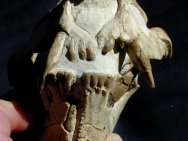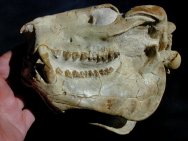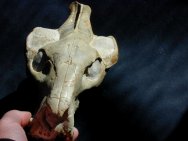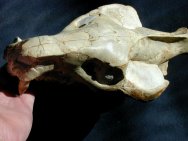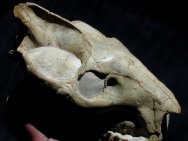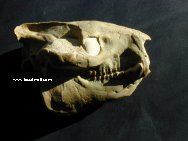 Description:
This is the largest and most pristine skull that I have yet offered.
The dentition is awesome. Three of the four canines are fully intact;
and the incisors and molars are fully in place. Believe me; you
wouldn’t want to have tangled with this growling, nasty little
beast when it roamed the grasslands and plains of ancient America.
The skull is solid and heavy in the hand. It most certainly would
be a centerpiece for a private collection, or, museum display grade
fossil. Description:
This is the largest and most pristine skull that I have yet offered.
The dentition is awesome. Three of the four canines are fully intact;
and the incisors and molars are fully in place. Believe me; you
wouldn’t want to have tangled with this growling, nasty little
beast when it roamed the grasslands and plains of ancient America.
The skull is solid and heavy in the hand. It most certainly would
be a centerpiece for a private collection, or, museum display grade
fossil.
The
badlands of the western US are particularly rich in mammal fossils
from the late Eocene to Miocene. The Brule Formation is exposed
over a huge area including Nebraska, North and South Dakota, Wyoming,
and Colorado, and yields abundant fossils as layers are eroded.
This diverse group of stocky prehistoric mammals grazed amid the
grasslands, prairies or savannas of North and Central America throughout
much of the Cenozoic era.
Oreodonta
is an extinct mammal distantly related to pigs, hogs, camels, hippopotamuses,
and the pig-like peccaries. Over 50 species of Oreodonta have been
described. They first appeared some 50 million years ago during
the warm Eocene and were widely prevalent during the Oligocene in
the grasslands, prairies or savannas of what is now the North American
badlands. The Oreodonts mysteriously disappeared some four million
years ago during the Pliocene. Today, fossil jaws and teeth of the
Oreodonta are commonly found in the White River badlands in South
Dakota, Nebraska, and Wyoming. Oreodonts have a unique place in
the evolution of ruminant teeth and with peccary-like attributes.
Oreodonts are Artiodactyls, even toed ungulates, sometimes called
a cross between a pig and a sheep. Note that they have both large
canine front teeth, but also molars for chewing plants. They were
herding animals and grazers, eating mostly grasses. They averaged
three to four feet long.
|



